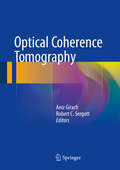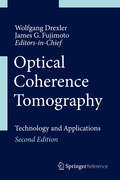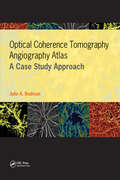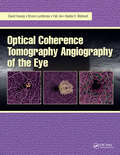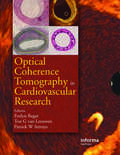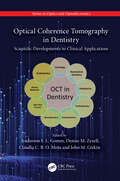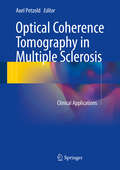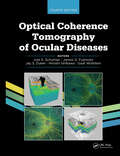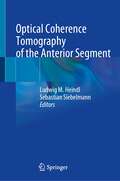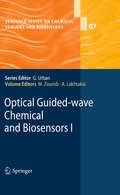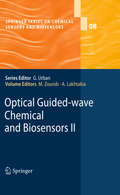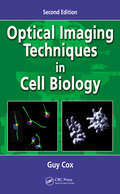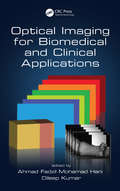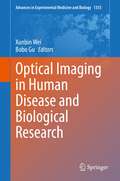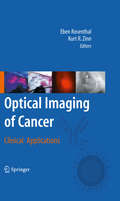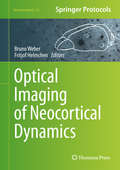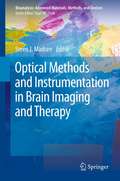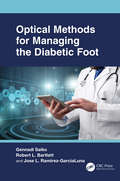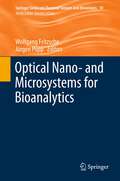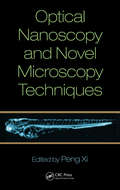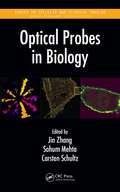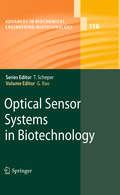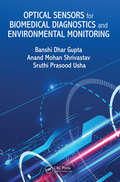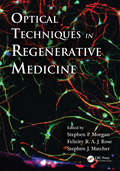- Table View
- List View
Optical Coherence Tomography
by Aniz Girach Robert C. SergottThis richly illustrated, comprehensive guide will enable the reader to identify anatomy and ophthalmic disease as illustrated on optical coherence tomography (OCT). It is the most up-to-date atlas of OCT images, many of which have been obtained with the newer OCT technologies that offer excellent image quality and definition at a microscopic level. All of the major disease areas in ophthalmology are covered, including diabetic retinopathy, age-related macular degeneration, uveitis, glaucoma, retinal vascular disease, and genetic abnormalities, and further hot topics are also considered. The chapters are written by leading international ophthalmologists from famous academic centers, and the numerous high-quality OCT images ensure that the reader will easily be able to follow the key issues. This book, with its clinical emphasis, will have wide appeal for residents, fellows, and experienced practitioners in ophthalmology, as well as optometrists and medical students and graduates.
Optical Coherence Tomography
by Wolfgang Drexler James G. FujimotoOptical coherence tomography (OCT) is the optical analog of ultrasound imaging and is a powerful imaging technique that enables non-invasive, in vivo, high resolution, cross-sectional imaging in biological tissue Between 30 to 40 Million OCT imaging procedures are performed per year in ophthalmology The overall market is estimated at more than 0. 5 Billion USD. A new generation OCT technology was developed, dramatically increasing resolution and speed, achieving in vivo optical biopsy, i. e. the visualization of tissue architectural morphology in situ and in real time Functional extensions of OCT technology enable non-invasive, depth resolved functional assessment and imaging of tissue. The book introduces OCT technology and applications not only from an optical and technological viewpoint, but also from the biomedical and clinical perspective This second edition is widely extended and covers significantly more topics then the first edition of this book. The chapters are written by leading international research groups, in a style comprehensible to a broad audience. It will be of interest not only to physicists, scientists and engineers, but also to biomedical and clinical researchers from different medical specialties.
Optical Coherence Tomography Angiography Atlas: A Case Study Approach
by Julie Rodman Dan EsmailiOptical Coherence Tomography Angiography (OCTA) is a novel, non-invasive, dyeless imaging modality that has emerged as an indispensable tool in the fields of optometry and ophthalmology. OCTA provides three-dimensional volumetric images of the retinal and choroidal vasculature by using a motion-contrast decorrelation algorithm. This cutting-edge imaging technology has widespread clinical utility as a non-invasive alternative for visualizing microvasculature in detail, but there are no textbooks dedicated to its use and the interpretation of scans. To fill this need, Optical Coherence Tomography Angiography Atlas: A Case Study Approach, by Dr. Julie A. Rodman, is a richly illustrated, practical guide to OCTA. It provides detailed information on the fundamental principles behind the technology, as well as clinical applications critical for accurate interpretation. The first section of the book discusses the principles behind OCTA and provides an introduction into the interpretation of OCTA images, including a chapter devoted to terminology. The remainder of the book provides detailed analysis of a myriad of inner and outer retinal disorders, including diseases of the optic nerve head. Most importantly for the clinical setting, the cases are presented with numerous images and a multitude of arrows and callouts to assist in the recognition of various clinical findings.Case examples include: Vascular Occlusive Disease Pigment Epithelial Detachment Choroidal Neovascular Membrane Diabetic Retinopathy Optic Disc Edema Dr. Rodman’s emphasis on the clinical use of OCTA technology and step-by-step interpretation of images makes Optical Coherence Tomography Angiography Atlas: A Case Study Approach a must-have resource for physicians, residents, students, and ophthalmic technicians looking for a simple, comprehensive guide to OCTA.
Optical Coherence Tomography Angiography of the Eye: OCT Angiography
by David Huang Bruno Lumbroso Yali Jia Nadia WaheedOptical coherence tomography (OCT) angiography is an important new imaging modality that is already being used by ophthalmologists in retina centers worldwide. It uses motion as intrinsic contrast, thus obviating the need to inject any intravenous dye. It uses infrared light that is invisible to the patient, and only requires few seconds per scan. This makes it both easier to use and much better tolerated by patients than traditional dye-based fluorescein angiography (FA) and indocyanine green (ICG) angiography. Inside Optical Coherence Tomography Angiography of the Eye Drs. David Huang, Bruno Lumbroso, Yali Jia, and Nadia Waheed include detailed information on clinical applications and fundamental principles needed to understand and use this new technology. This includes information on high-speed OCT systems, algorithms to extract flow contrast, the appearance of the normal eye, the findings in myriad diseases, and tips on how to deal with artifact and pitfalls. The 3-dimensional nature of OCT angiography provides visualization that was not possible before with either FA or ICG and readers will come to appreciate how this enables the visualization of previously difficult to image vascular beds such as the 4 retinal vascular plexuses (radial peripapillary, superficial, intermediate, and deep), the choriocapillaris, and the deeper choroidal vessels. Given its noninvasive nature and ease of use, OCT angiography imaging is rapidly taking an important place in everyday ophthalmology and may soon replace fluorescein angiography in everyday practice.Optical Coherence Tomography Angiography of the Eye is designed to be the definitive text on this cutting-edge technology for the retina specialist and comprehensive ophthalmologist.
Optical Coherence Tomography in Cardiovascular Research
by Patrick W Serruys Evelyn Regar Ton G van LeeuwenGiven that for centuries, the standard tool to understand diseases in tissues was the microscope and that its major limitation was that only excised tissue could be used, recent technology now permits the examination of diseased tissue in vivo. Optical coherence tomography (OCT) has promising potential when applied to coronary artery disease. OCT h
Optical Coherence Tomography in Dentistry: Scientific Developments to Clinical Applications (Series in Optics and Optoelectronics)
by Gomes, Anderson S. L.Optical Coherence Tomography (OCT), a method to "see inside of things" without destroying them, has been applied to subjects ranging from materials science to medicine. This book focuses on the biomedical application of OCT in dentistry, covering topics from dental materials to clinical practice. Since the introduction of the OCT method in ophthalmology in 1991, and then dentistry in 1998, developments in OCT methods, particularly in biomedical areas, have led to its dissemination worldwide. The chapters of this book cover the basics and recent global advances of OCT in dentistry, including an overview of the method and its use in cariology, restorative dentistry, dental materials, endodontics, pediatric dentistry, orthodontics, prosthodontics, soft oral tissues and nanodentistry. This book will be of interest to both newcomers in the field as well as those already working in OCT, either in research and/or the clinic. It will be of great use in courses on optical imaging applied to biomedical areas, particularly where it can provide real-life examples of the application of OCT.
Optical Coherence Tomography in Multiple Sclerosis
by Axel PetzoldThis book gives a clinical context to optical coherence tomography (OCT) findings, while considering the differential diagnosis and providing patient management guidance. Relevant anatomical and technical aspects are discussed, followed by a pragmatic illustration of the use of OCT for the clinical spectrum of multiple sclerosis and optic neuritis, and finishing with information on monitoring ocular side effects of recently approved disease-modifying treatments in multiple sclerosis. Optical Coherence Tomography in Multiple Sclerosis: Clinical Applications is aimed at clinical neurologists working with patients suffering from MS and general neurologists who see patients with visual symptoms in their daily practice. Ophthalmologists sharing clinical responsibilities with neurologists for patients under disease-modifying treatments will also find the book of interest.
Optical Coherence Tomography in Neurological Diseases
by Peter A. Calabresi Laura J. Balcer Elliot M. FrohmanOptical coherence tomography [OCT] provides tissue morphology imagery at much higher resolution than other imaging modalities such as MRI or ultrasound, and the machines are comparatively cheaper. It is an easy technique to perform; is non-ionizing, and therefore safe. These benefits are driving a rapid transformation of OCT, from its principal application as a research tool, into an extension of the 'neurological examination' in routine office practice. Originally used in assessing the severity of tissue damage and prognosis of multiple sclerosis and various neuro-ophthalmic conditions, OCT is increasingly used in other neurological disorders such as Parkinson's disease, ALS, and Alzheimer's disease. This book is the first comprehensive review of the use of OCT in neurological diseases. The coverage includes a description of the technique and its utilization in a variety of neurologic conditions. Essential reading for neurologists, neuro-ophthalmologists, and neuroradiologists wanting an introductory account of the clinical applications of OCT. The first comprehensive review of the clinical use of OCT in a wide range of neurological diseases Practical, reflecting the rapid move of OCT into routine office practice. Extensively illustrated in color, with sample case-histories and the expertise of leading physicians.
Optical Coherence Tomography of Ocular Diseases
by James G. Fujimoto Hiroshi Ishikawa Joel S. Schuman Jay DukerThe most comprehensive text and definitive guide for nearly 30 years about optical coherence tomography (OCT) imaging in ophthalmology, Optical Coherence Tomography of Ocular Diseases, Fourth Edition covers a range of subjects, from principles and operation techniques to clinical interpretation and the latest innovations in OCT. Written by the pioneers of OCT technologies and the world-renowned OCT researchers Drs. Joel S. Schuman, James G. Fujimoto, Jay S. Duker, Hiroshi Ishikawa, and Gadi Wollstein, Optical Coherence Tomography of Ocular Diseases, Fourth Edition is an essential text for imaging technology.OCT now occupies a dominant role as a diagnostic tool for retinal conditions and glaucoma. At the same time, the technology continues to show potential for emerging clinical and research applications across all the ophthalmological subspecialties. To reflect these rapid advances, this new edition of Optical Coherence Tomography of Ocular Diseases features a complete and thorough revision of the existing text as well as the addition of cutting-edge content to bring this classic resource completely up to date.New content in the Fourth Edition includes:• OCT angiography• Swept-source OCT• OCT in multimodal imaging• Clinical utility of OCT in glaucoma prediction and progression detection • OCT for neuro-ophthalmology Optical Coherence Tomography of Ocular Diseases, Fourth Edition is the one and only book needed by practitioners who use OCT for clinical eye care.
Optical Coherence Tomography of the Anterior Segment
by Ludwig M. Heindl Sebastian SiebelmannThis book is a highly illustrated, practical guide to anterior segment optical coherence tomography (OCT) with numerous photographs and didactic information throughout. Clear and concise chapters outline the diagnostics of the anterior segment of the eye with clinical advice given to support ophthalmic surgeons with pre and intraoperative surgery planning as well as postoperative follow-up care. Optical Coherence Tomography of the Anterior Segment will be a useful resource for everyday practice to allow clinicians to grow their expertise in this patient-friendly and common diagnostic procedure. As the procedure continues to gain popularity, this book will be an indispensable resource for all levels of ophthalmologist who wish to improve their knowledge and techniques of anterior segment OCT.
Optical Guided-wave Chemical and Biosensors I
by Mohammed Zourob Akhlesh LakhtakiaFor the first time, distinguished scientists from key institutions worldwide provide a comprehensive approach to optical sensing techniques employing the phenomenon of guided wave propagation for chemical and biosensors. This includes both state-of the-art fundamentals and innovative applications of these techniques. The authors present a deep analysis of their particular subjects in a way to address the needs of novice researchers such as graduate students and post-doctoral scholars as well as of established researchers seeking new avenues. Researchers and practitioners who need a solid foundation or reference will find this work invaluable. This first of two volumes contains eight chapters covering planar waveguides for sensing, as well as sensing techniques based on plasmonic waveguides.
Optical Guided-wave Chemical and Biosensors II
by Mohammed Zourob Akhlesh LakhtakiaFor the first time, distinguished scientists from key institutions worldwide provide a comprehensive approach to optical sensing techniques employing the phenomenon of guided wave propagation for chemical and biosensors. This includes both state-of the-art fundamentals and innovative applications of these techniques. The authors present a deep analysis of their particular subjects in a way to address the needs of novice researchers such as graduate students and post-doctoral scholars as well as of established researchers seeking new avenues. Researchers and practitioners who need a solid foundation or reference will find this work invaluable. This second of two volumes covers the incorporation of periodic structures in waveguides to exploit the Bragg phenomenon, optical fiber sensors, hollow waveguides and micro-resonators as well as a review of the tremendous expansion of terahertz technology for sensing applications.
Optical Imaging Techniques in Cell Biology
by Guy CoxOptical Imaging Techniques in Cell Biology, Second Edition covers the field of biological microscopy, from the optics of the microscope to the latest advances in imaging below the traditional resolution limit. It includes the techniques-such as labeling by immunofluorescence and fluorescent proteins-which have revolutionized cell biology. Quantitat
Optical Imaging for Biomedical and Clinical Applications
by Ahmad Fadzil Mohamad Hani and Dileep KumarOptical imaging is a rapidly emerging imaging technique that has been successfjully translated into biomedical applications ranging from clinical diagnosis to molecular biology. This book includes an introductory section to explore various optical imaging devices and their functionality and roles for biomedical applications such as dermatology and ophthalmology. Recent developments as exemplified with the authors research are explored in detail. In depth discussion of other disease conditions and their diagnosis with optical imaging techniques are also covered.
Optical Imaging in Human Disease and Biological Research (Advances in Experimental Medicine and Biology #3233)
by Xunbin Wei Bobo GuThe book introduces readers to the basic principle of optical imaging technologies. Focusing on human disease diagnostics using optical imaging methods, it provides essential information for researchers in various fields and discusses the latest trends in optical imaging. In recent decades, there has been a huge increase in imaging technologies and their applications in human diseases diagnostics, including magnetic resonance imaging, x-ray computed tomography, and nuclear tomographic imaging. This book promotes further developments to extend optical imaging to a wider range of disease diagnostics. It is a valuable resource for researchers and students in the field of biomedical optics, as well as for clinicians.
Optical Imaging of Cancer
by Kurt R. Zinn Eben RosenthalTo describe principles of optical imaging including chemistry and physics of fluorescence, limitations/advantages of optical imaging compared to metabolic and anatomic imaging. Describe hardware adapted for small animal imaging and for clinical applications: endoscopes and operative microscopes. Outline FDA approved and newer optical imaging probes. Include discussion of chemistry and linkage to other proteins. Review current techniques to image cancer and the development of techniques to specifically image cancer cells. Review use of exploiting differences in tissue autofluorescence to diagnose and treat cancer. Include agents such as 5-aminoleculinic acid. Review mechanisms that require proteolytic processing within the tumor to become active fluorophores. Review use of cancer selective proteins to localize probes to cancer cells: include toxins, antibodies, and minibodies. Introduction of plasmids, viruses or other genetic material may be used to express fluorescent agents in vivo. This chapter will review multiple vectors and delivery mechanisms of optical imaging cassettes.Preclinical investigations into the use of optical contrast agents for the detection of primary tumors in conventional and orthotopic models will be discussed. Preclinical investigations into the use of optical contrast agents for the detection of metastatic tumors in mouse models will be discussed. Use of targeted and non-specific optical contrast agents have been used for the detection of sentinel lymph node detection. These applications and how they differ from other applications will be discussed. Because of the unique difficulty of identifying tumor from normal tissue in brain tissue, a separate chapter would be needed. More clinical data is available for this cancer type than any other. Discussion of potential clinical applications for optical imaging and an assessment of the potential market.
Optical Imaging of Neocortical Dynamics
by Bruno Weber Fritjof HelmchenThe application of optical methods for investigating neocortical circuit dynamics has greatly expanded in recent years, providing novel insights into the fascinating world of brain function. Optical Imaging of Neocortical Dynamics presents a guide to these indispensible tools, which cover a broad range of spatiotemporal scales and a large variety of signaling aspects, ranging from voltage changes to metabolic states. This detailed volume specifically explores methods that are applied in experiments on living brains (in vivo) and that relate to functional properties on the spatial scale of cortical circuits. Beginning with an introductory section that focuses on physical fundamentals of optical imaging as well as molecular tools used for in vivo optical imaging and optogenetic control, the book continues with the most relevant methods and their applications to investigate changes in neuronal and glial activity states as well as optical imaging methods probing metabolic states. Written for the Neuromethods series, this volume contains the kind of detail and key implementation advice that ensures successful results in the lab. Practical and easy to use, Optical Imaging of Neocortical Dynamics serves as an ideal guide for researchers who aim to apply these highly valuable tools to their own neuroscientific studies. "
Optical Methods and Instrumentation in Brain Imaging and Therapy
by Steen J. MadsenThis book provides a comprehensive up-to-date review of optical approaches used in brain imaging and therapy. It covers a variety of imaging approaches including diffuse optical imaging, laser speckle imaging, photoacoustic imaging and optical coherence tomography. A number of laser-based therapeutic techniques are reviewed, including photodynamic therapy, fluorescence guided resection and photothermal therapy. Fundamental principles and instrumentation are discussed for each imaging and therapeutic approach.
Optical Methods for Managing the Diabetic Foot
by Gennadi Saiko Robert L. Bartlett Jose L. Ramirez-GarciaLunaThis book discusses optical technologies for Diabetic Foot management. It combines the current medical literature review with an overview of the technology and physics behind it. Thus, it is a single-source introduction to the topic. It can also be used as a reference source and practical guide for the use of technology. The particular focus is on low-cost technologies, including hyperspectral imaging, thermography, and endogenous bacterial fluorescence. Moving diagnostic modalities closer to the patient (e.g., primary care) allows the disease to be detected at an earlier stage, thus improving outcomes. However, while some optical technologies are available commercially, they have not received wide clinical adoption due to gaps in knowledge translation to mainstream medicine. This book aims to narrow this gap with practical illustrations. The book will be of interest to a broad range of healthcare professionals, clinical researchers, engineers, and decision-makers, who are dealing with complications of diabetes. Key Features: Reviews the current state of technologies. Provides a practical guide with practical considerations and illustrations. Supplies a 360-degree view of the combination of clinical information with a technology background and primers on physics and engineering.
Optical Nano- and Microsystems for Bioanalytics
by Jürgen Popp Wolfgang FritzscheThis book describes the state of the art in the field of bioanalytical nano- and microsystems with optical functionality. In 12 chapters distinguished scientists and leaders in their respective fields show how various optical technologies have been miniaturized and integrated over the last few decades in order to be combined with nano- and microsystems for applications in the life sciences. The main detection and characterization technologies are introduced, and examples of the superiority of these integrated approaches compared to traditional ones are provided. Examples from e.g. the fields of optical waveguides, integrated interferometers, surface plasmon resonance or Raman spectroscopy are introduced and discussed, and it is shown how these approaches have led to novel functionalities and thereby novel applications.
Optical Nanoscopy and Novel Microscopy Techniques
by Peng XiMicroscopy is at the forefront of multidisciplinary research. It was developed by physicists, made specific by chemists, and applied by biologists and doctors to better understand how the human body works. For this very reason, the field has been revolutionized in past decades.The objective of Optical Nanoscopy and Novel Microscopy Techniques is to
Optical Probes in Biology (Series in Cellular and Clinical Imaging)
by Jin Zhang Carsten Schultz Sohum MehtaOptical probes, particularly the fluorescent varieties, enable researchers to observe cellular events in real time and with great spatial resolution. Optical Probes in Biology explores the diverse capabilities of these powerful and versatile tools and presents various approaches used to design, develop, and implement them. The book examines the use
Optical Sensor Systems in Biotechnology
by Govind RaoOptical Sensor Systems in Biotechnology covers trends in this modern biotechnology. The book treats all aspects of this interdisciplinary technology, where knowledge, methods and expertise are required from a broad range of disciplines.
Optical Sensors for Biomedical Diagnostics and Environmental Monitoring
by Banshi Dhar Gupta Anand Mohan Shrivastav Sruthi Prasood UshaThe field of plasmonics has shown extraordinary capabilities in realizing highly sensitive and accurate sensors for environmental monitoring and measurement of biological analytes. The inherent potential of such devices has led to growing interest worldwide in commercial fiber optic chemical and biosensors. Optical Sensors for Biomedical Diagnostics and Environmental Monitoring is an essential resource for students, established researchers, and industry developers in need of a reference work on both the fundamentals and latest advances in optical fiber sensor technology in biomedical diagnostics and environmental monitoring. The book includes rigorous theory and experimental techniques of surface plasmon and lossy mode resonances, as well as real-time sensing applications of resonance techniques implemented over optical fiber substrate using bulk layer and/or nanostructures as transducer and sensing layers. In addition, discussion of various design options for real-time sensors in environmental monitoring and biomedical diagnostics make the book approachable to readers from multidisciplinary fields.
Optical Techniques in Regenerative Medicine
by Stephen P. Morgan Felicity R. A. J. Rose Stephen J. MatcherIn regenerative medicine, tissue engineers largely rely on destructive and time-consuming techniques that do not allow in situ and spatial monitoring of tissue growth. Furthermore, once the therapy is implanted in the patient, clinicians are often unable to monitor what is happening in the body. To tackle these barriers, optical techniques have bee
